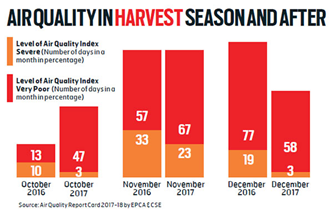


Fig. Deterioration in air quality during harvest season
- Pollution by stubble burning has become an annual phenomenon in large parts of northern India. Rice Growing States, including Punjab, Haryana and Delhi add to the problem of stubble burning managing the stubble becomes a constant for the farmers because of adapter cropping pattern.
- The only reason to burn this asset that can yield income and fertility to soil is the small gap of time between harvesting of Paddy and sowing of wheat, the other main crop. Also, the farmers have limited access to dispose the straw clean the land and prepare the seedbed for wheat will in time.
- Managing the stubble becomes a constraint for the farmers because of the adopted cropping pattern. The only reason to burn this asset that can yield income and fertility to the soil is the small gap of time between harvesting of paddy and sowing of wheat, the other main crop.
- Also, the farmers have limited access to dispose the straw, clean the land and prepare the seed bed for wheat well in time.
- Growth of paddy Cultivation in Punjab Rice was not a traditional crop of Punjab; but with increased availability in electricity, the number of tube wells increased, which in turn increased the areas for cultivation of paddy replacing the area under cultivation of pulses and other commercial crop.
- Punjab had been contributing about 60 per cent of the share in the food stocks of paddy even with only 1.5 per cent of the area. Apart from burning of paddy straw, the state has other problems like overuse of chemicals, depleting in the water table etc.
- The Minimum Support Price (MSP) was provided to paddy along with its marketing assurance by State Procurement. There are only two crop, wheat and paddy, that have assured marketing through state procurement.
Strategies to Deal with the Problem Cooperative Model
- Reduction of the sizeable area under paddy would not be a feasible alternative in order to ensure enough food stock. Therefore, the issue of straw burning has to be settled through other measures like manufacturing of paper and cardboard, production of mushroom where paddy straw can be used as raw material, etc.
- But there is skepticism that an individual farmer may not install such a unit irrespective of the size of the farm he is holding. Also, a single unit even of the largest size cannot be economical because the straw is spread throughout the area and transportation to a single point would be a constraint.
- Therefore, the Cooperative Model, already experienced in the dairy, is the most viable and prudent option in addressing this problem.
- There is a need of at least two cardboard and paper manufacturing units in every block. A cooperative society in the area with the membership of local farmers and farm laborers can be formed and such units must be affiliated to the apex body of the State federation of cooperative for rice straw management.
- Such patronization can yield the most desirable results not only to tackle this problem but also to generate income and employment in the state. Production od Biogas Production of biogas needs technical help and extension services.
- The cooperative umbrella of the same pattern can however help the farmers and farm labourers throughout the State in this venture.
Assured Marketing of Other Crops
- In Punjab 89% of the farmers have their holding less than 10 acers. These farmers are therefore unable to take any risk either of volatile price or of marketing. In case of rice, price and marketing is assured.
- The same assurance has to be granted for the alternative crops to increase the area of cultivation under them.
Conclusion: Stubble burning has to be stopped. But looking into the real problem at micro as well as macro level concerned with food security and concerns of farm community at large, it should we dealt sympathetically with the alternative majors and cooperative model is stands out to be the most appropriate approach to address this problem, which is more viable and sustainable. Small Scale Farmers would be satisfied with less but assured income than the drift towards commercial crops irrespective of their profit that have any risk of fluctuating price and yield.
Related Articles

